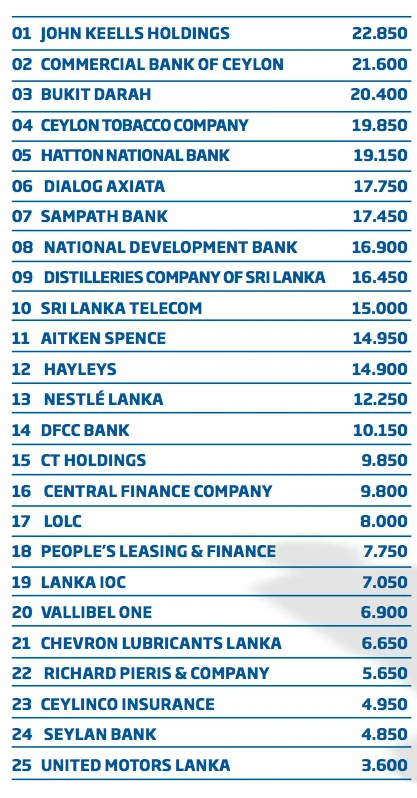
Performance of Corporate Sri Lanka: Business Today Top Twenty Five 2012–2013
Sri Lanka experienced a growth rate of 6.4 percent in 2012 and is expected to reach 6.8 percent in 2013. Though the sudden dip in growth from over eight percent of the previous two years (2010 and 2011) to 6.4 percent (2012) caused alarm and the slow down in the economy was felt by all sections of the country, in actual fact this reflected the resilience of the Sri Lankan economy. The financial year 2012-2013 was not an easy one, there were severe climatic changes—droughts and floods, Eurozone crisis, and the country had to go through a rapid adjustment of exchange rate depreciation and tight monetary policy stance. However, as evident from the performance of the corporate sector, none stopped growing (except for the motor industry), they sought ways and means to overcome the challenges that came their way. The Business Today TOP TWENTY FIVE 2012–2013 essentially reflects that the corporates that have always been key players have remained so. What does this mean? It is open to interpretation, however it could also mean that the Sri Lankan corporate sector has the resilience and the acumen to adapt to any environment.
2012, saw the government introducing stringent policy measures to ensure macroeconomic stabilisation to overcome the challenges posed by the global economy and to curtail the increase in domestic credit. Increase in imports and rising oil prices had a major effect throughout the economy where the stability of the balance of payments was undermined by the widening trade deficit. Sri Lanka continues to shoulder the burden of four loss making public enterprises, where their losses are being financed by the Government and State sector banks. If these public enterprises are turned around to profit making organisations, bank interest rates would come down and inflation can reach mid single digit inflation with the correct monetary policies where the funds will be available in banks for people to borrow at low cost.
Corruption, is not a phenomena that is prevalent only or one that emerged within the State sector, the private sector too needs to recognise its role in enabling corruption to continue. Corruption within any organisation, public or private, will affect the common man. Greater discipline and transparency, where an equal playing field is maintained will be essential as Sri Lanka moves forward in an era where greater opportunities are available.
The Colombo Stock Exchange (CSE), which was a respected institution in the country and a primary mechanism to generate funds for companies, is today considered to be rampant with insider trading and market manipulation.This has occured especially after 2009, where new players were seen entering the market. While the CSE is not yet a mature market where stringent regulation could be applied without dampening the overall spirit, individuals or groups whose behaviours are detrimental to the overall performance of the CSE should be penalised.
Post 2009, has seen many new entrants to the private sector in Sri Lanka. This is encouraging as the entrepreneurial spirit of the country is being nurtured. Yet, a more recent phenomena that can be seen is rapid wealth generation of some of the newer entrants, which is not a ‘bad thing’, but it would be prudent to follow a more cautionary path. Monopolistic behaviour in certain industries is still evident. For all to benefit and for the progress of the country, it is essential that the opportunities present are available for all.
The dedication and commitment of the Treasury, Ministry of Finance and Planning and the Central Bank have ensured that the Sri Lankan economy has been able to withstand the pressures exerted by unfavourable global conditions and as well as domestic challenges. Though at times the policy decisions may have been unpopular, the measures taken have been in the best interest of the country as made evident by the resilience of the Sri Lankan economy.
As can be seen from the Business Today TOP TWENTY FIVE, the private sector has recognised the importance of aligning themselves with the national development agenda. And, while the economic environment during the said financial year was somewhat challenging, the corporates looked at ways of increasing productivity while reducing costs. Furthermore, they looked at opportunities not only in Sri Lanka, but also targeted new markets. Innovation, diversification, consolidation and sustainability as well as expansion are areas in which the TOP TWENTY FIVE companies have strategised in, thereby ensuring increased revenue though at times profit may have been less than expected.
The entry of three finance companies and five banks in the Business Today TOP TWENTY FIVE indicate that there is greater activity in the financial services sector, where products and services are sought to a much larger extent than previously. Is this a reflection of greater economic activity?
Large scale development is happening around the country—from the commissioning of Sri Lanka’s second international airport in Mattala, the reconstruction of the Northern Railway, opening of the Colombo-Katunayake Expressway, and commissioning of the Colombo South Port Terminal amongst many others—Sri Lanka is building capacity for the next 20–30 years. Colombo is a completely new city with areas for leisure and relaxation and heritage buildings have been developed to create commercial spaces.
While international names have come into the country, especially in the tourism and leisure sector, Sri Lankan companies too are gradually entering the fray. While the post conflict era has opened doors in many directions, the government as well as the private sector need to identify the opportunities and development strategies that are suitable for Sri Lanka. Sri Lanka should not always emulate the growth strategies of countries that may have come from similar backgrounds (i.e. post conflict) as the culture and environment of all nations are different. Sri Lanka has to identify the potential as well as suitability when entering new segments within a sector. Ideally regulatory mechanisms should be in place while in certain instances flexibility may also be required.
As Sri Lanka forges ahead to become a USD 4,000 per capita income nation in 2016, the country can be proud of the progress it has made so far. All economic indicators have improved; including unemployment and poverty. All must recognise that the Sri Lankan economy is a new economy of four years. As such ‘we’ must run the race, but to win the race ‘we’ have to be intelligent and proactive where the private sector should not work in isolation and focus on individual benefit but be a partner of progress, as the State sector and private sector are the two constants that balance the equation.
Business Today wishes to congratulate the Business Today TOP TWENTY FIVE winners for the financial year 2012–2013.
The Business Today TOP TWENTY FIVE is strictly based on the published information of companies listed in the Colombo Stock Exchange. Financial criteria considered include Share Turnover, Revenue, Profit after Tax, Growth in Sales Turnover, Growth in Profit, Return on Equity, Growth in Earnings per Share, Market Capitalisation, Value of Shares Transacted and Value Addition. Furthermore, weights are assigned to the criteria uniformly without any prejudice. These are not disclosed due to proprietary reasons.
The Business Today TOP TWENTY FIVE have been selected on the basis of their financial performance during the financial year ending December 31, 2012 and March 31, 2013 with the assistance of KPMG Ford Rhodes, Thornton & Co.
9 Distilleries Company of Sri Lanka






